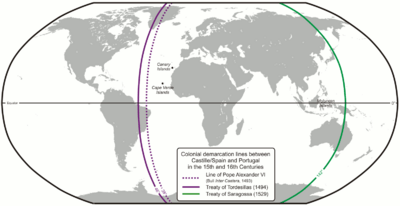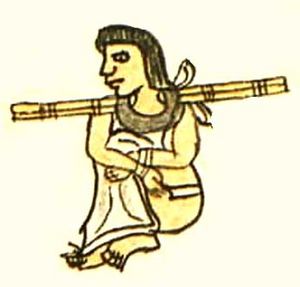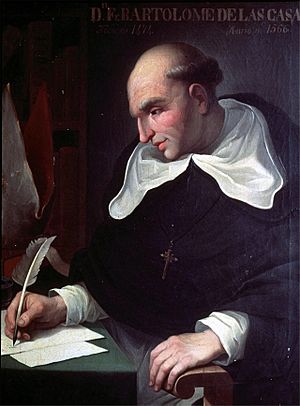Slavery in colonial Spanish America facts for kids
Slavery in the Spanish American colonies was a system where people were treated as property. This system existed across the Spanish Empire, including in Spain itself. In their lands in the Americas, Spain was one of the first European powers to try and stop the enslavement of indigenous people. However, Native American slavery still happened, especially until new laws were made in 1543.
The Spanish Empire was also involved in the Atlantic slave trade, which brought enslaved people from Africa. Even though Spain often relied on other countries to get and transport these enslaved Africans, about 22% of all Africans brought to the Americas ended up in the Spanish Empire.
Spain made laws to limit and even forbid the enslavement of Native Americans early on. These laws included the Laws of Burgos in 1512 and the New Laws in 1542. The New Laws also ended the encomienda system. This system gave groups of Native Americans to individual Spaniards or Native American nobles. They were supposed to care for them but often forced them to work. When the New Laws were put into action, tens of thousands of Native Americans were freed. This caused some rebellions and plots by the encomenderos (people who held encomiendas), which the Spanish government had to stop. Asian people in colonial Mexico had the same rights as Native Americans, so they could not be enslaved by law.
Slavery had existed in Spain since the time of the Roman Empire. It also existed among some Native American groups in Meso-America and South America. The Spanish government tried to limit the enslavement of indigenous people. They did not want slavery to be based on a person's race.
Spanish explorers, called conquistadors, saw forced labor and tributes from Native Americans as rewards for their conquests. The government gave some conquerors encomiendas. People in encomiendas were not slaves, but their work was required and they were paid very little. They did have some rights and could take their managers to court. They were also supposed to be "cared for" by the encomendado, which often meant teaching them about Christianity.
When many Native Americans in the Caribbean died, Spaniards started raiding other islands and the mainland to enslave more indigenous people for their settlements. By 1810, as sugar became a major product to sell, Spaniards used more and more enslaved African people for labor on large farms called plantations. Besides plantation work, enslaved people also worked in cities in homes, religious places, and workshops.
Spanish slavery in the Americas was different from other European powers because Spain tried to end Native American slavery early on. Even though Spain did not directly participate in the trans-Atlantic slave trade, enslaved Black people were sold throughout the Spanish Empire, especially in the Caribbean. During the colonial period, Spanish lands were the largest and wealthiest in the Americas.
Since the Spanish government stopped its own people from joining the Atlantic slave trade, the right to bring enslaved people into these Spanish lands was a big goal for other European countries. This right was called the Asiento de Negros. It even led to many European wars, like the War of the Spanish Succession. In the mid-1800s, most countries in the Americas ended slavery. But Cuba and Puerto Rico, the last two Spanish colonies in the Americas, were among the last to do so, only before Brazil.
Enslaved people fought against their captivity in many ways. They mixed non-European ideas into Christianity, creating new religious practices. They also formed their own communities outside the plantations, known as Maroon communities. The first open rebellion by Black people happened on Spanish plantations in 1521.
Resistance to the enslavement of indigenous people also came from Spanish religious leaders and lawyers. The first speech in the Americas arguing for human rights and against the abuses of slavery was given in Hispaniola, just 19 years after the first contact with Europeans. The fight against indigenous captivity in the Spanish colonies led to the first modern discussions about whether slavery was right or wrong.
Uniquely in the Spanish American colonies, laws like the New Laws of 1542 were passed early in the colonial period to protect Native Americans from being enslaved. Also, Spain's loose control over its vast American lands and its unstable economy made it harder for large slave-operated plantations to spread widely. Overall, the struggle against slavery in the Spanish American colonies created a strong tradition of opposition that helped start conversations about human rights.
Contents
Slavery Before the New World
Slavery in Spain goes back to the times of the Greeks, Phoenicians, and Romans. It was common across different cultures and groups. Slavery also played a big part in the economies of Spain and other countries.
The Romans used many enslaved people for labor. Their laws, like the Code of Justinian, defined the status of slaves. When Christianity grew, the idea was that Christians should not enslave other Christians, but this practice still continued. When Islam spread and conquered most of the Iberian Peninsula in the 700s, slavery decreased in the remaining Christian kingdoms.
In the Muslim-controlled area of Al-Andalus, Muslims were not allowed to enslave other Muslims. However, there was a trade of non-Muslim slaves, involving Muslims and Jewish merchants. Christians and Jews who stayed in Muslim lands could keep their slaves if they paid a special tax. But non-Muslims could not own Muslim slaves. If a slave converted to Islam, their owner had to sell them to a Muslim.
During the reconquista, Christian Spain fought to take back land from Muslims. This changed the rules about slavery. At first, enslaving Christians was allowed, but from the 8th to the 11th centuries, Christian kingdoms slowly stopped this. They then only enslaved Muslims from Al-Andalus. Conquered Muslims were sometimes enslaved to force them to convert, but often, Muslim captives could be bought back by their families.
The Siete Partidas, a law code from the 1200s by Alfonso X of Castile, explained who could be enslaved. This included people captured in a fair war, children of enslaved mothers, and those who sold themselves into slavery. It also said that masters should treat their slaves well. At this time, slavery was usually for domestic work and was often a temporary situation for outsiders. The Siete Partidas also called slavery "the lowest and most miserable condition" because a person, who is meant to be free, becomes someone else's property.
As Spain (Castile) and Portugal explored overseas, they conquered islands off the coast of Africa, like the Canary Islands and São Tomé. They started growing sugar cane there. They saw the native people of these islands as less than human, which they used to justify enslaving them. The Canary Islands came under Spanish control. By the early 1500s, most of the native people had died, and enslaved Africans replaced them for labor. Many West African states were involved in slave raiding and trading. The enslaved people the Spanish bought were considered legitimate slaves. African states traded enslaved people for European goods like firearms and horses.
Both Spain and Portugal set up sugar cane farms on the Atlantic islands, using enslaved labor. This system, with sugar mills and large investments, was later copied in the New World on a much bigger scale.
Portugal's exploration of the African coast and the division of overseas lands by the Treaty of Tordesillas meant Portugal controlled the African slave trade. However, as Spain settled in the Caribbean, they needed African slaves. Black enslaved people in Spain mostly worked as house servants. Owning them became a sign of wealth for rich Spanish families, though on a smaller scale than in Portugal. Artisans also bought Black slaves and trained them in their crafts, which helped their businesses.
Another type of forced labor used in the New World, which also came from Spain, was the encomienda. This system was first used by Spaniards in the Canary Islands after their conquest. However, the native population there quickly declined. The encomienda system became much more common after the Spanish arrived in Mexico and Peru.
Protecting Native Americans from Forced Labor
Before the Spanish colonization of the Americas, slavery was common among some Pre-Columbian indigenous peoples, especially the Aztecs. When the Spanish conquered and settled in the New World, they quickly forced many indigenous people, mainly the Taíno in the Caribbean, to work for them. This had terrible effects on the native population.
Unlike Portugal, the Spanish government, led by the Catholic Monarchs, opposed enslaving native peoples in the new lands for religious reasons. When Christopher Columbus returned with indigenous slaves, the monarchs ordered the survivors to be sent back home. In 1512, after pressure from Dominican friars, the Laws of Burgos were created to protect the rights and freedom of natives in the New World. A papal order called Sublimis Deus in 1537 also officially banned the enslavement of indigenous peoples, but it was canceled a year later.
The encomienda system, another major form of forced labor, was also ended. This made the conquistadors angry, as they expected to keep their grants forever. It was replaced by the repartimiento system.
After the New Laws of 1542 were passed, the Spanish greatly limited the power of the encomienda system. They also officially ended the enslavement of the native population. However, indigenous people who rebelled against the Spanish could still be enslaved. For example, after the Mixtón War (1540-42) in Mexico, many indigenous people were captured and moved as slaves. Laws in 1573 also forbade attacking independent Native American groups without permission. They also required a "protector of Indians," a church representative who would defend Native Americans in legal cases. Later in the 1500s, in Peru, thousands of indigenous men were forced to work in the silver mines of Potosí. This was done through a continuation of the pre-Hispanic Inca mita tradition, which was a system of forced labor for public works.
Enslaving Mapuche Rebels
King Philip III of Spain faced a tough situation in Colonial Chile. The Arauco War was raging, and the local Mapuche people successfully destroyed seven Spanish cities between 1598 and 1604. In response, Philip lifted the ban on enslaving Native Americans captured in war in 1608.
Spanish settlers in the Chiloé Archipelago misused this decree. They launched slave raids against groups like the Chono people of Patagonia, who had never been under Spanish rule or rebelled. In the 1650s, the Real Audiencia of Santiago (a high court) said that the enslavement of Mapuches was a main reason for the constant war between the Spanish and the Mapuche. Slavery for Mapuches "caught in war" was finally ended in 1683, after many years of the Spanish government trying to stop it.
Africans in the Early Colonies
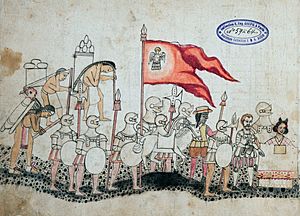
When Spain first enslaved Native Americans on Hispaniola and then replaced them with captive Africans, they made slave labor the basis for producing sugar in the colonies. Europeans believed that Africans were more resistant to European diseases than Native Americans. In 1501, Spanish colonists began bringing enslaved Africans from the Iberian Peninsula to their colony in Santo Domingo on Hispaniola. These first Africans had been enslaved in Europe before coming to the Americas. They might have spoken Spanish and even been Christians. About 17 of them worked in copper mines, and about a hundred were sent to find gold.
As Old World diseases killed many native people in the Caribbean in the early 1500s, enslaved Black people from Africa (called bozales) gradually took over their labor. However, they also mixed with and joined Native Americans in escaping to freedom. They created mixed-race maroon communities on all the islands where Europeans had established chattel slavery (where people are treated as property).
Spanish colonist and Dominican friar Bartolomé de las Casas (1484–1566) saw and wrote about the terrible effects of enslavement on Native populations. At first, he tried to protect indigenous people by supporting and taking part in the African slave trade. But he later argued that enslaving both indigenous people and Africans was wrong and violated their human rights. Las Casas fought for protections for indigenous people, especially limits on the encomienda system, helping to bring about the 1542 New Laws.
In Spanish Florida, the first enslaved Africans arrived in 1526 with Lucas Vázquez de Ayllón's settlement of San Miguel de Gualdape on the Georgia coast. They rebelled and lived with indigenous people, destroying the colony in less than two months. More enslaved people arrived in Florida in 1539 with Hernando de Soto and in 1565 with the founding of St. Augustine, Florida. Native Americans were also enslaved in Florida through the encomienda system.
Enslaved people escaping to Florida from the colony of Georgia were freed by King Carlos II's order on November 7, 1693, if they converted to Catholicism. Florida became a safe place for enslaved people fleeing the Thirteen Colonies.
In this early period, enslaved African men often worked as labor bosses, overseeing indigenous workers. Franciscan Toribio de Benavente Motolinia (1482-1568), one of the first twelve Franciscans to arrive in Mexico in 1524, called Black people the "Fourth Plague" on Mexican Indians. He wrote that these Black overseers were very cruel, overloading indigenous people with work and sending them far from their homes, causing many to die. In Yucatan, there were rules trying to prevent Black people from living in indigenous communities. In Mexico City in 1537, some Black people were accused of rebellion. They were executed by hanging in the main plaza, an event recorded in an indigenous manuscript.
The demand for African slaves was high, and the slave trade was controlled by the Portuguese. They set up trading posts on the west coast of Africa. Spanish colonists bought enslaved people directly from Portuguese traders, who in turn bought them from African traders. As Spain relied more on enslaved Africans and opposed enslaving indigenous people (except in cases of rebellion), slavery became linked to race and a hierarchy of races. Europeans developed stronger ideas about racial differences. These ideas were supported by older beliefs like limpieza de sangre (purity of blood), which in Spain referred to people without Jewish or Muslim ancestors. However, in Spanish America, "purity of blood" came to mean a person free of any African ancestry.
At that time, each enslaved African who arrived in the Americas was called a ""Pieza de Indias" (a piece of the Indies). The government gave special permits, called asientos, to merchants to trade slaves. This regulated the trade. During the 1500s, the Spanish colonies were the biggest buyers in the Atlantic slave trade, with thousands of sales. But other European colonies soon bought even more enslaved workers, driving the slave market to huge levels.
Some of the first Black people in the Americas were "Atlantic Creoles." These were mixed-race men of African and Portuguese/Spanish descent. Some were enslaved, others were free. They sailed with Iberian ships and worked in ports in Spain and Portugal. Some were born in Europe, others in African ports as children of Portuguese traders and African women. African slaves were also taken to Portugal, where they married local women. These mixed-race men often grew up speaking two languages, which made them useful as interpreters in African and Iberian ports.
Some famous Black Spanish soldiers in the early Spanish conquest of America included Juan Valiente and Juan Beltrán in Chile, Juan Garrido (who first harvested wheat in New Spain) and Sebastián Toral in Mexico, Juan Bardales in Honduras and Panama, and Juan García in Peru.
The first known Christian marriage in the continental United States was between a free Black Spanish woman from Jerez de la Frontera and a Spanish settler from Segovia. They met in Seville and traveled together to the New World. This marriage happened in 1565 in the Spanish settlement of St. Augustine, Florida.
Estevanico, an enslaved Black man from Morocco, survived the terrible Narváez expedition from 1527 to 1536, where most men died. After losing ships, horses, equipment, and most of the men, Estevanico and three other survivors spent six years traveling overland from what is now Texas to Sinaloa, finally reaching the Spanish settlement in Mexico City. He learned several Native American languages. He became a respected guide. Later, while leading an expedition in what is now New Mexico to find the Seven Cities of Gold, he was killed in a conflict with the Zuñi people.
Black Slavery in the Later Colonial Period
The number of enslaved people in Cuba greatly increased when the British captured Havana during the Seven Years' War. They brought 10,000 enslaved people from their other colonies in the West Indies to work on new farms. These enslaved people were left behind when the British returned Havana to Spain as part of the 1763 Treaty of Paris. They form a big part of the Afro-Cuban population today.
Historians have studied sugar production by enslaved workers in 19th-century Cuba. But they sometimes missed the important role of the Spanish government before the 1760s. Cuba eventually had two different but connected ways of using enslaved labor, which came together in the late 1700s. The first was in cities and was mostly for the needs of the Spanish colonial government, peaking in the 1760s. By 1778, it was reported that about 52,000 enslaved people were brought from Africa to the West Indies by Europeans, with about 4,000 brought by the Spanish.
The second way, which grew after 1790, was in rural areas. It was run by private slaveholders and farmers who produced goods like sugar to sell. After 1763, the need for defense projects led the government to use many of its enslaved workers in ways that were similar to the intense work on sugar plantations in the 1800s. Another important group of enslaved workers used by the Spanish colonial government in the late 1700s were the king's laborers, who worked on the city's fortifications.
The Spanish colonies were slow to use enslaved labor for growing sugarcane, especially in Cuba. The Spanish colonies in the Caribbean were among the last to end slavery. While the British abolished slavery by 1833, Spain abolished slavery in Puerto Rico in 1873. On the mainland colonies, Spain ended African slavery in the 1700s. Peru was one of the countries that brought back slavery for some decades after gaining independence from Spain in the early 1800s.
Escaping Slavery in Spanish Lands
On May 29, 1680, the Spanish government declared that enslaved people escaping to Spanish lands from other Caribbean islands would be free if they became Catholic. Similar decrees were issued for escaping French slaves in 1680 and 1685. On November 7, 1693, King Carlos II issued a decree freeing all enslaved people escaping from English colonies who accepted Catholicism. There were similar decrees in 1733, 1740, 1750, and 1753.
Since 1687, Spanish Florida attracted many enslaved Africans who escaped from slavery in the Thirteen Colonies. Since 1623, the official Spanish policy was that any enslaved person who reached Spanish land and asked for refuge could become a free Spanish citizen. They would be helped to start their own businesses if they had a trade, or given land to farm if they were farmers. In return, they had to convert to Catholicism and serve for some years in the Spanish military. Most settled in a community called Gracia Real de Santa Teresa de Mose, the first settlement of free Africans in North America. The enslaved African Francisco Menéndez escaped from South Carolina and traveled to St. Augustine, Florida. He became the leader of the settlers at Mose and commander of the Black militia there from 1726 until after 1742.
The formerly enslaved people also found safety among the Creek and Seminole Native Americans. These groups had settled in Florida at the invitation of the Spanish government. In 1771, Florida Governor John Moultrie wrote that "it has been a practice for a good while past, for negroes to run away from their Masters, and get into the Indian towns, from whence it proved very difficult to get them back." When officials asked the Native Americans to return the escaped slaves, they replied that they had "merely given hungry people food, and invited the slaveholders to catch the runaways themselves."
After the American Revolutionary War, enslaved people from Georgia and South Carolina escaped to Florida. The U.S. Army made more frequent attacks into Spanish territory. This included the 1817–1818 campaign by Andrew Jackson, known as the First Seminole War. After this, the United States effectively controlled East Florida (from the Atlantic to the Appalachicola River). According to Secretary of State John Quincy Adams, the U.S. had to act because Florida had become "a place open to every enemy... of the United States." Spain asked Britain for help, but London refused. Some of President James Monroe's cabinet wanted Jackson fired, but Adams realized Jackson's actions had put the U.S. in a good position for talks. Adams negotiated very good terms.
Since Florida was a burden to Spain, which could not afford to send settlers or soldiers, Spain decided to give the territory to the United States. This happened through the Adams–Onís Treaty in 1819, which became effective in 1821.
Ending Slavery
Support for abolitionism (the movement to end slavery) grew in Great Britain. Slavery in France's Caribbean colonies was ended by a Revolutionary decree in 1794. (Slavery in France itself was abolished in 1315 by Louis X of France). But it was brought back by Napoleon I in 1802. Enslaved people in Saint-Domingue rebelled in response and gained independence after a brutal conflict. The victorious former slaves founded the republic of Haiti in 1804.
Later slave revolts were part of a rise in ideas about individual rights and freedoms. These ideas came from the Age of Enlightenment and the French Revolution in Europe. As freedom became more real, the enslaved people's idea of freedom changed. They no longer wanted to overthrow white people and create African societies. Most enslaved people were "creole," meaning they were born where they lived, and they imagined their freedom within the existing society.
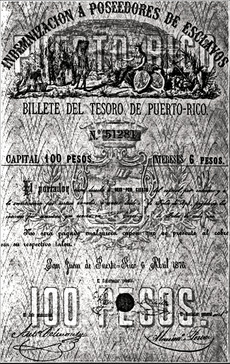
The Spanish American wars of independence freed most of Spain's overseas lands. In the Americas, many new nations formed from these wars. The wars were influenced by Enlightenment ideas and economic issues, which also led to the reduction and end of feudalism (a system where peasants worked for lords). For example, in Mexico on December 6, 1810, Miguel Hidalgo, a leader of the independence movement, issued a decree ending slavery. He threatened death to those who did not obey. In South America, Simón Bolívar abolished slavery in the lands he conquered. However, it was not a smooth process everywhere. Some countries, like Peru and Ecuador, brought back slavery for some time after gaining independence.
In a treaty in 1814, King Ferdinand of Spain promised to consider ways to end the slave trade. In a treaty on September 23, 1817, with Great Britain, the Spanish government said it wanted to "co-operate with His Britannic Majesty in adopting the cause of humanity." The king promised that the slave trade would be abolished in all Spanish lands by May 30, 1820. After that date, no Spanish subject could buy or trade slaves on the coast of Africa. The final end date was October 30. Spanish subjects were also forbidden from carrying slaves for anyone outside Spanish lands or using the Spanish flag to hide such dealings.
The Assembly of Year XIII (1813) in the United Provinces of the Río de la Plata declared the "freedom of wombs." This did not end slavery completely, but it freed the children of enslaved people. Many enslaved people gained freedom by joining armies, either against royalists during the War of Independence or during later Civil Wars. For example, the Argentine Confederation finally ended slavery with its Argentine Constitution of 1853.
|



